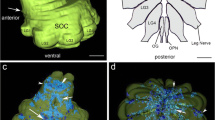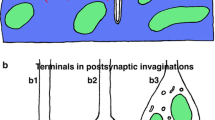Summary
In serial sections of neurons in the paravertebral ganglia of the frog (Limnodynastes dumerili), the postsynaptic structures termed ‘postsynaptic bar’ (PSB) and ‘junctional subsurface organ’ (JSO) were never observed in the same ganglion cell. Further, PSBs were found mostly in small ganglion cells (less than 22 μm), while JSOs were found mostly in large ganglion cells (up to 45 μm). Between 10 and 22 PSBs were located at both ‘spine’ and ‘non-spinous’ somatic synapses of the smaller ganglion cells; while 8 to 16 JSOs were located largely in the axon hillock region of the larger ganglion cells.
Based on these observations, it is suggested that the two ganglion cell populations represent the B and C cell types defined according to electrophysiological data. Further, since the nerve terminals adjacent to both these postsynaptic structures appear to be cholinergic according to their vesicular content, this provides some basis for suggesting that JSOs are associated with slow excitatory synapses, while PSBs are present at slow inhibitory synapses.
Similar content being viewed by others
References
De Robertis, E. D. P. andBennett, H. S. (1955) Some features of the submicroscopic morphology of synapses in frog and earthworm.Journal of Biophysical and Biochemical Cytology 1, 47–58.
Eccles, R. M. andLibet, B. (1961) Origin and blockade of the synaptic responses of curarized sympathetic ganglia.Journal of Physiology 157, 484–503.
Fujimoto, S. (1967) Some observations on the fine structure of the sympathetic ganglion of the toad,Bufo vulgaris japonicus.Archivum Histologicum Japonicum 28, 313–35.
Gabella, G. (1976)Structure of the autonomic nervous system. London: Chapman and Hall.
Hendry, I. A. (1976) A method to correct adequately for the change in neuronal size when estimating neuronal numbers after nerve growth factor treatment.Journal of Neurocytology 5, 337–49.
Hill, C. E., Watanabe, H. andBurnstock, G. (1975) Distribution and morphology of amphibian extra-adrenal chromaffin tissue.Cell and Tissue Research 60, 371–87.
Hill, C. E. andBurnstock, G. (1975) Amphibian sympathetic ganglia in tissue culture.Cell and Tissue Research 162, 209–33.
Honma, S. (1970a) Histochemical demonstration of catecholamines in the toad sympathetic ganglia.Japanese Journal of Physiology 20, 186–97.
Honma, S. (1970b) Functional differentiation in sB and sC neurons of toad symapthetic ganglia.Japanese Journal of Physiology 20, 281–95.
Koketsu, K. (1969) Cholinergic synaptic potentials and the underlying ionic mechanisms.Federation Proceedings 28, 101–12.
Koketsu, K. andYamamoto, K. (1975) Unusual cholinergic response of bullfrog sympathetic ganglion cells.European Journal of Pharmacology 31, 281–6.
Konigsmark, B. W., Kalyanaraman, V. P., Corey, P. andMurphy, E. A. (1970) An evaluation of techniques in neuronal population estimates: the sixth nerve nucleus.Johns Hopkins Medical Journal 125, 146–58.
Libet, B. (1967) Long latent periods and further analysis of slow synaptic responses in sympathetic ganglia.Journal of Neurophysiology 30, 494–514.
Libet, B. (1970) Generation of slow inhibitory and excitatory postsynaptic potentials.Federation Proceedings 29, 1945–56.
Libet, B., Chichibu, S. andTosaka, T. (1968) Slow synaptic responses and excitability in sympathetic ganglia of the bullfrog.Journal of Neurophysiology 31, 383–95.
Libet, B. andKobayashi, H. (1974) Adrenergic mediation of slow inhibitory postsynaptic potential in sympathetic ganglia of the frog.Journal of Neurophysiology 37, 805–14.
Libet, B. andOwman, Ch. (1974) Concomitant changes in formaldehyde-induced fluorescence of dopamine interneurones and in slow inhibitory postsynaptic potentials of the rabbit superior cervical ganglion, induced by stimulation of the preganglionic nerve or by a muscarinic agent.Journal of Physiology 237, 635–62.
Mizell, S. (1965) Seasonal changes in energy reserves in the common frog,Rana pipiens.Journal of Cellular and Comparative Physiology 66, 251–8.
Nakamura, M. andKoketsu, K. (1972) The effect of adrenaline on sympathetic ganglion cells of bullfrogs.Life Sciences 11, 1165–73.
Nishi, S., Soeda, H. andKoketsu, K. (1965) Studies on sympathetic B and C neurons and patterns of preganglionic innervation.Journal of Cellular and Comparative Physiology 66, 19–32.
Nishi, S., Soeda, H. andKoketsu, K. (1967) Release of acetylcholine from sympathetic preganglionic nerve terminals.Journal of Neurophysiology 30, 114–34.
Nishi, S. andKoketsu, K. (1968) Early and late after-discharges of amphibian sympathetic ganglion cells.Journal of Neurophysiology 31, 109–21.
Norberg, K.-A. andMcIsaac, R. J. (1967) Cellular location of adrenergic amines in frog sympathetic ganglia.Experientia 23, 1052.
Pick, J. (1963) The submicroscopic organization of the sympathetic ganglion in the frog (Rana pipiens).Journal of Comparative Neurology 120, 409–62.
Pick, J. (1970)The autonomic nervous system. Morphological, comparative, clinical and surgical aspects. Philadelphia and Toronto: J. B. Lippincott Company.
Piezzi, R. S. andRodriguez Echandia, E. L. (1968) Studies on the para-renal ganglion of the toadBufo arenarum Hensel. I. Its normal fine structure and histochemical characteristics.Zeitschrift für Zellforschung und mikroskopische Anatomie 88, 180–6.
Purves, R. D. (1976) Function of muscarinic and nicotinic acetylcholine receptors.Nature 261, 149–51.
Sotelo, C. (1968) Permanence of postsynaptic specializations in the frog sympathetic ganglion cells after denervation.Experimental Brain Research 6, 294–305.
Taxi, J. (1961) Etude de l'ultrastructure des zones synaptiques dans les ganglions sympathiques de la grenouille.Comptes rendus de l'Académie des Sciences, Paris 252, 174–6.
Taxi, J. (1967) Observations on the ultrastructure of the ganglionic neurons and synapses of the frogRana esculenta L. In:The Neuron (edited byHyden, H.), pp. 221–54. Amsterdam, London and New York: Elsevier Publishing Company.
Taxi, J. (1976) Morphology of the autonomic nervous system. In:Frog Neurobiology, (edited byR. Llinás andW. Precht), pp. 93–150. Berlin: Springer-Verlag.
Tosaka, T., Chichibu, S. andLibet, B. (1968) Intracellular analysis of slow inhibitory and excitatory postsynaptic potentials in sympathetic ganglia of the frog.Journal of Neurophysiology 31, 396–409.
Uchizono, K. (1964) On different types of synaptic vesicles in the sympathetic ganglia of amphibia.Japanese Journal of Physiology 14, 210–19.
Uchizono, K. andOhsawa, K. (1973) Morpho-physiological consideration on synaptic transmission in the amphibian sympathetic ganglion.Acta Physiologica Polanica 24, 205–14.
Watanabe, H. andBurnstock, G. (1976a) Junctional subsurface organs in frog sympathetic ganglion cells.Journal of Neurocytology 5, 125–136.
Watanabe, H. andBurnstock, G. (1976b) A special type of small granule-containing cell in the abdominal para-aortic region of the frog.Journal of Neurocytology 5, 465–78.
Weibel, E. R. (1973) Stereological techniques for electron microscopic morphometry. In:Principles and techniques of electron microscopy (edited byHayat, M. A.)Biological applications.3, pp. 237–296. New York, Cincinnati, Toronto, London and Melbourne: Van Nostrand Reinhold Company.
Weight, F. F. andVotata, J. (1970) Slow synaptic excitation in sympathetic ganglion cells: evidence for synaptic inactivation of potassium conductance.Science 170, 755–8.
Weight, F. F. andPadjen, A. (1973a) Slow synaptic inhibition: evidence for synaptic inactivation of sodium conductance in sympathetic ganglion cells.Brain Research 55, 219–24.
Weight, F. F. andPadjen, A. (1973b) Acetylcholine and slow synaptic inhibition in frog sympathetic ganglion cells.Brain Research 55, 225–8.
Weitsen, H. A. andWeight, F. F. (1973) Chromaffin cells in the frog sympathetic ganglion: morphology not consistent with role in generation of synaptic potentials.Anatomical Record 175, 467.
Yamamoto, T. (1963) Some observations on the fine structure of the sympathetic ganglion of bullfrog.Journal of Cell Biology 16, 159–70.
Author information
Authors and Affiliations
Rights and permissions
About this article
Cite this article
Watanabe, H., Burnstock, G. Postsynaptic specializations at excitatory and inhibitory cholinergic synapses. J Neurocytol 7, 119–133 (1978). https://doi.org/10.1007/BF01213464
Received:
Revised:
Accepted:
Issue Date:
DOI: https://doi.org/10.1007/BF01213464




